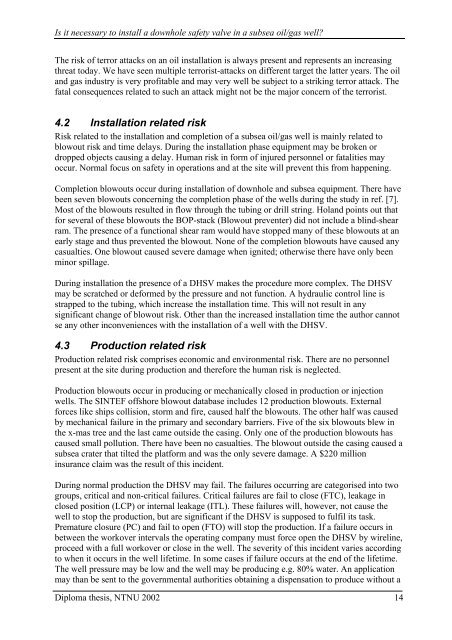Is it necessary to install a downhole safety valve in a subsea ... - NTNU
Is it necessary to install a downhole safety valve in a subsea ... - NTNU
Is it necessary to install a downhole safety valve in a subsea ... - NTNU
You also want an ePaper? Increase the reach of your titles
YUMPU automatically turns print PDFs into web optimized ePapers that Google loves.
<strong>Is</strong> <strong>it</strong> <strong>necessary</strong> <strong>to</strong> <strong><strong>in</strong>stall</strong> a <strong>downhole</strong> <strong>safety</strong> <strong>valve</strong> <strong>in</strong> a <strong>subsea</strong> oil/gas well?<br />
The risk of terror attacks on an oil <strong><strong>in</strong>stall</strong>ation is always present and represents an <strong>in</strong>creas<strong>in</strong>g<br />
threat <strong>to</strong>day. We have seen multiple terrorist-attacks on different target the latter years. The oil<br />
and gas <strong>in</strong>dustry is very prof<strong>it</strong>able and may very well be subject <strong>to</strong> a strik<strong>in</strong>g terror attack. The<br />
fatal consequences related <strong>to</strong> such an attack might not be the major concern of the terrorist.<br />
4.2 Installation related risk<br />
Risk related <strong>to</strong> the <strong><strong>in</strong>stall</strong>ation and completion of a <strong>subsea</strong> oil/gas well is ma<strong>in</strong>ly related <strong>to</strong><br />
blowout risk and time delays. Dur<strong>in</strong>g the <strong><strong>in</strong>stall</strong>ation phase equipment may be broken or<br />
dropped objects caus<strong>in</strong>g a delay. Human risk <strong>in</strong> form of <strong>in</strong>jured personnel or fatal<strong>it</strong>ies may<br />
occur. Normal focus on <strong>safety</strong> <strong>in</strong> operations and at the s<strong>it</strong>e will prevent this from happen<strong>in</strong>g.<br />
Completion blowouts occur dur<strong>in</strong>g <strong><strong>in</strong>stall</strong>ation of <strong>downhole</strong> and <strong>subsea</strong> equipment. There have<br />
been seven blowouts concern<strong>in</strong>g the completion phase of the wells dur<strong>in</strong>g the study <strong>in</strong> ref. [7].<br />
Most of the blowouts resulted <strong>in</strong> flow through the tub<strong>in</strong>g or drill str<strong>in</strong>g. Holand po<strong>in</strong>ts out that<br />
for several of these blowouts the BOP-stack (Blowout preventer) did not <strong>in</strong>clude a bl<strong>in</strong>d-shear<br />
ram. The presence of a functional shear ram would have s<strong>to</strong>pped many of these blowouts at an<br />
early stage and thus prevented the blowout. None of the completion blowouts have caused any<br />
casualties. One blowout caused severe damage when ign<strong>it</strong>ed; otherwise there have only been<br />
m<strong>in</strong>or spillage.<br />
Dur<strong>in</strong>g <strong><strong>in</strong>stall</strong>ation the presence of a DHSV makes the procedure more complex. The DHSV<br />
may be scratched or deformed by the pressure and not function. A hydraulic control l<strong>in</strong>e is<br />
strapped <strong>to</strong> the tub<strong>in</strong>g, which <strong>in</strong>crease the <strong><strong>in</strong>stall</strong>ation time. This will not result <strong>in</strong> any<br />
significant change of blowout risk. Other than the <strong>in</strong>creased <strong><strong>in</strong>stall</strong>ation time the author cannot<br />
se any other <strong>in</strong>conveniences w<strong>it</strong>h the <strong><strong>in</strong>stall</strong>ation of a well w<strong>it</strong>h the DHSV.<br />
4.3 Production related risk<br />
Production related risk comprises economic and environmental risk. There are no personnel<br />
present at the s<strong>it</strong>e dur<strong>in</strong>g production and therefore the human risk is neglected.<br />
Production blowouts occur <strong>in</strong> produc<strong>in</strong>g or mechanically closed <strong>in</strong> production or <strong>in</strong>jection<br />
wells. The SINTEF offshore blowout database <strong>in</strong>cludes 12 production blowouts. External<br />
forces like ships collision, s<strong>to</strong>rm and fire, caused half the blowouts. The other half was caused<br />
by mechanical failure <strong>in</strong> the primary and secondary barriers. Five of the six blowouts blew <strong>in</strong><br />
the x-mas tree and the last came outside the cas<strong>in</strong>g. Only one of the production blowouts has<br />
caused small pollution. There have been no casualties. The blowout outside the cas<strong>in</strong>g caused a<br />
<strong>subsea</strong> crater that tilted the platform and was the only severe damage. A $220 million<br />
<strong>in</strong>surance claim was the result of this <strong>in</strong>cident.<br />
Dur<strong>in</strong>g normal production the DHSV may fail. The failures occurr<strong>in</strong>g are categorised <strong>in</strong><strong>to</strong> two<br />
groups, cr<strong>it</strong>ical and non-cr<strong>it</strong>ical failures. Cr<strong>it</strong>ical failures are fail <strong>to</strong> close (FTC), leakage <strong>in</strong><br />
closed pos<strong>it</strong>ion (LCP) or <strong>in</strong>ternal leakage (ITL). These failures will, however, not cause the<br />
well <strong>to</strong> s<strong>to</strong>p the production, but are significant if the DHSV is supposed <strong>to</strong> fulfil <strong>it</strong>s task.<br />
Premature closure (PC) and fail <strong>to</strong> open (FTO) will s<strong>to</strong>p the production. If a failure occurs <strong>in</strong><br />
between the workover <strong>in</strong>tervals the operat<strong>in</strong>g company must force open the DHSV by wirel<strong>in</strong>e,<br />
proceed w<strong>it</strong>h a full workover or close <strong>in</strong> the well. The sever<strong>it</strong>y of this <strong>in</strong>cident varies accord<strong>in</strong>g<br />
<strong>to</strong> when <strong>it</strong> occurs <strong>in</strong> the well lifetime. In some cases if failure occurs at the end of the lifetime.<br />
The well pressure may be low and the well may be produc<strong>in</strong>g e.g. 80% water. An application<br />
may than be sent <strong>to</strong> the governmental author<strong>it</strong>ies obta<strong>in</strong><strong>in</strong>g a dispensation <strong>to</strong> produce w<strong>it</strong>hout a<br />
Diploma thesis, <strong>NTNU</strong> 2002<br />
14


